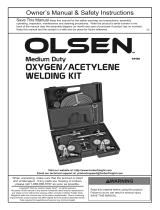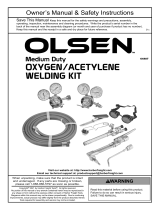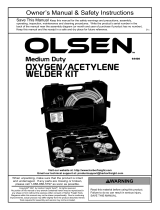
5.3. Close the regulators by turning the adjusting screws anti-clockwise to relieve the pressure on the diaphragm before opening the cylinder
valves. Slowly open the cylinder valve on the oxygen and acetylene bottles in turn. As you do so the high pressure gauge (left hand) on
each regulator will register the pressure in the cylinder to which it is attached.
5.3.1. Slowly open each regulator in turn by turning the adjusting knob clockwise. As you do so the outlet pressure gauge (right hand) on each
regulatorwillregistertheoutletpressureofgasbeingfedtothetorch.Adjustthepressureaccordingtothesizeofnozzleinuseandthe
thickness of the material to be cut or welded. Refer to section 8 in the chart overleaf.
WARNING! Never set acetylene regulator at a delivery pressure above 15psi (1bar).
5.3.2. After adjusting the regulators to the desired operating pressures check connections for leaks using an approved leak detection solution.
Check for leaks at all connections. If a leak is found, tighten fitting more securely. If leak persists, discontinue use and call your supplier.
5.3.3. Briefly open and close the oxygen valve on the torch handle to check that the gas is flowing.
5.3.4. Similarly open and close the acetylene valve on the torch handle to check that the gas is flowing.
WARNING! Always use welding gloves and suitable eye protection when welding or cutting. Contact your local Sealey stockist for a full
range of protective equipment.
5.4. LIGHTING THE TORCH Ensure that the gas hoses will not be in the way of the torch when ignited. Ensure that the torch is facing away
from you before lighting.
5.4.1. Holding the torch in one hand and the striker in the other open the acetylene valve a 1/4 turn (the valve knob is colour coded red).
Operate the striker close to the tip to light the acetylene.
5.4.2. The first flame that appears will be an orange/yellow colour giving off a small amount of black smoke from its tip. If too much acetylene is
flowing the flame will be standing away from the tip of the torch making a roaring noise. In extreme cases this type of flame can blow itself
out. To correct such a flame reduce the amount of acetylene until the flame is 8 to 10 inches long with less black smoke.
5.4.3. Once the acetylene flame is set correctly begin to introduce oxygen by slowly opening the oxygen control valve on the torch (The valve
knob is colour coded blue). The flame will change to a whitish colour and the black smoke will disappear. This flame is not hot enough for
welding.
5.4.4. Add more oxygen to the flame by further opening the control knob until a brilliant neutral flame is achieved.
5.5. SHUTTING DOWN AND LEAVING SAFE
5.5.1. Turn off the acetylene valve on the torch first and then turn off the oxygen valve a few moments later.
Note: Turning the gases off in the wrong order can cause damage to the torch.
5.5.2. Close both cylinder valves.
5.5.3. Drain gas from oxygen regulator by opening the oxygen valve on the torch handle. Similarly drain gas from the acetylene regulator.
5.5.4. Release the adjusting knobs on the regulators. This is done by turning them anti-clockwise.
6. CUTTING OPERATION
IMPORTANT! LEAK TEST ALL CONNECTIONS AND VALVES PRIOR TO EACH USE OF THE EQUIPMENT.
Note: These instructions are intended to describe the facilities and operation of the welding/cutting torch. They are not
intended to teach you how to weld or cut using oxyacetylene. If you have no experience of welding/cutting using
oxyacetylene it is essential that you seek training from a qualified person or approved training organisation.
Assemble the torch for cutting as described in section 4.5 (See also fig.3)
6.1. GAS CONTROL WHEN USING THE CUTTING SET-UP
6.1.1. The control of the oxygen and acetylene flows on the cutting set-up differs from the welding set-up in the following ways:
6.1.2. The oxygen control valve on the torch handle should be fully opened so that regulation of the oxygen flow takes place using only the
oxygen control valve on the cutting attachment (see fig.3A).
6.1.3. The flow of the acetylene is still controlled by the red coded knob on the torch handle.
6.1.4. The flame is then set up using these two control valves only.
6.1.5. Once the flame is set additional oxygen can be introduced into the centre of the flame to initiate the cutting process by operating the
oxygen control lever (see fig.3B) mounted on the cutting attachment.
6.1.6. SETTING THE GAS REGULATOR PRESSURES
6.1.7. Close the regulators by turning the adjusting screws anti-clockwise to relieve the pressure on the diaphragm before opening the cylinder
valves. Slowly open the cylinder valve on the oxygen and acetylene bottles in turn. As you do so the high pressure gauge (left hand) on
each regulator will register the pressure in the cylinder to which it is attached.
6.1.8. Slowly open each regulator in turn by turning the adjusting knob clockwise. As you do so the outlet pressure gauge (right hand) on each
regulatorwillregistertheoutletpressureofgasbeingfedtothetorch.Adjustthepressureaccordingtothesizeofnozzleinuseandthe
thickness of the material to be cut or welded. Refer to the chart in section 8.
WARNING! Never set acetylene regulator at a delivery pressure above 15psi (1bar).
6.1.9. After adjusting the regulators to the desired operating pressures check connections for leaks using an approved leak detection solution.
Check for leaks at all connections. If a leak is found, tighten fitting more securely. If leak persists, discontinue use and call your supplier.
6.1.10. Briefly open and close the acetylene valve on the torch handle to check that the gas is flowing.
6.1.11. Ensure that the oxygen control valve on the cutting attachment is closed.
6.1.12. Fully open the oxygen control valve on the torch handle.
6.1.13. Briefly open and close the oxygen control valve on the cutting attachment to check that the gas is flowing.
6.1.14. Brieflyoperatetheoxygencontrolleveronthecuttingattachmenttocheckthatthegasisflowingfromthecentreofthecuttingnozzle.
WARNING! Always use welding gloves and suitable eye protection when welding or cutting. Contact your local Sealey dealer for
a full range of protective equipment.
6.2. LIGHTING THE TORCH
6.2.1. Ensure that the gas hoses will not be in the way of the torch when ignited. Ensure that the torch is facing away from you before lighting.
6.2.2. Holding the torch in one hand and the striker in the other open the acetylene valve on the torch handle a 1/4 turn (the valve knob is colour
coded red). Operate the striker close to the tip to light the acetylene.
6.2.3. The cutting tip has six separate holes in it arranged radially and each of these holes will have a small flame coming from it. Develop the
correct flame at each hole by alternately increasing the flow of acetylene and then oxygen until a neutral flame is achieved at each hole
having a white cone about an 1/8” long.
6.3. USING THE OXYGEN CONTROL LEVER
6.3.1. Use the pre-heat flame to heat the metal to be cut to a cherry red colour. When the metal reaches this stage press the oxygen control
lever to initiate the cutting process. This feeds additional oxygen through a central hole in the cutting tip.
Original Language Version
© Jack Sealey Limited SGA1.V4 Issue:4 (1,4) 10/8/21









